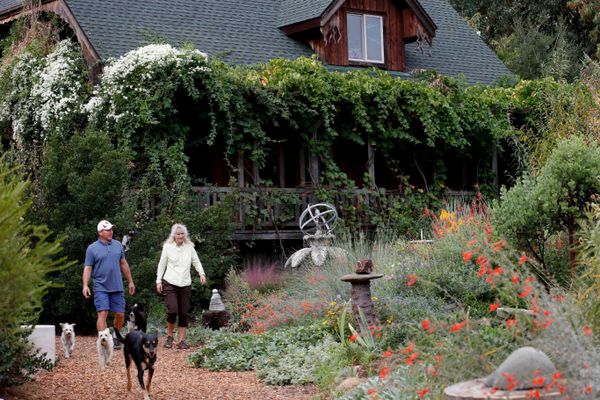
Kate Frey and husband Ben Frey stroll in their verdant garden, which emphasizes sustainable, organic and habitat features. (All photos: Brant Ward/San Francisco Chronicle)
A profusion of flowers and beneficial insects in every season …
CALIFORNIA Hopland – As fall enters the calendar, a time of year when most gardens are looking more than a bit done, Kate Frey’s garden, off a quiet lane on the southern edge of Hopland (Mendocino County), remains a profusion of flowers. Bees and a host of other insects flit from bloom to bloom; trills and chirps of birdsong add background music to the colorful display.
It’s a delightful 1-acre garden, one that friends and family love to ramble. But, most importantly, it’s an experimental garden designed to illustrate, as Frey says, “that if you plant certain plants, despite drought conditions, beneficial pollinators will come in every season.”
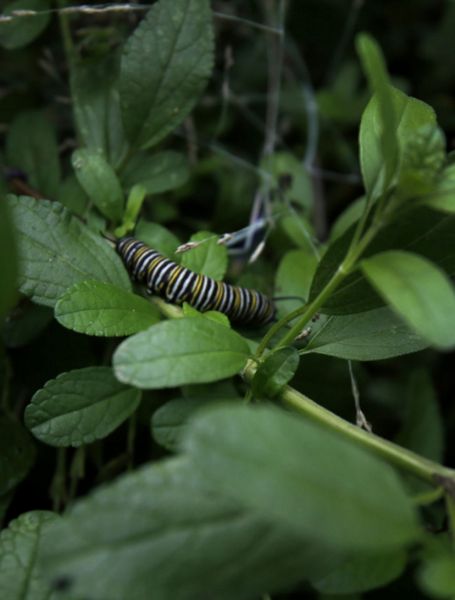
A monarch caterpillar perches in a shady spot in Kate Frey’s four-season garden.
Sustainable habitat gardens a specialty …
Frey, garden designer and consultant, specializes in the creation of sustainable, organic, habitat gardens that reflect the climate conditions, soil and biodiversity of their locations and provide abundant habitat for pollinators through all four seasons of the year.
For 18 years, beginning in 1986, Frey designed and managed the 6-acre, organic, sustainable garden at Fetzer Vineyards. In 2003, representing Fetzer, she created a garden for the prestigious Chelsea Flower Show in London, walking away with a silver. Gold medals rewarded her returns in 2005 and 2007. Each display was enhanced with Frey’s husband Ben’s fanciful salvaged-wood interpretations of a tower, shed and garden furniture.
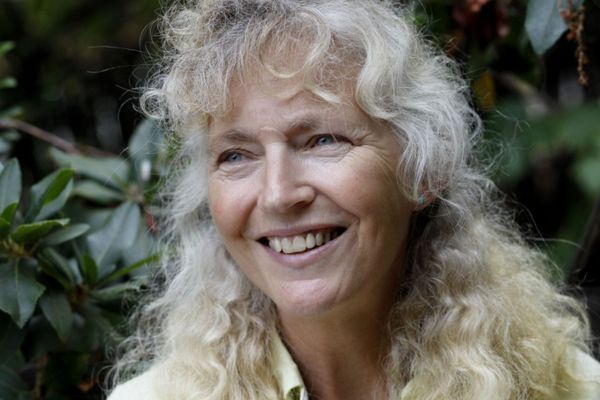
Landscape designer Kate Frey revels in the four-season pollinator garden she designed in Hopland.
Invitations to participate in other international shows followed, as well as the opportunity, recently completed, for the couple to consult and work part time in Saudi Arabia on a Saudi prince’s organic farm.
Plant diversity is a primary goal …
Frey’s goal in her home garden, in any season, is to have a minimum of eight to 11 species of plants blooming at the same time. “Plant diversity attracts a diversity of beneficial insects — beetles, ladybugs, moths, lacewings, bats, wasps, hover flies, butterflies and, of course, honeybees and native bees.”
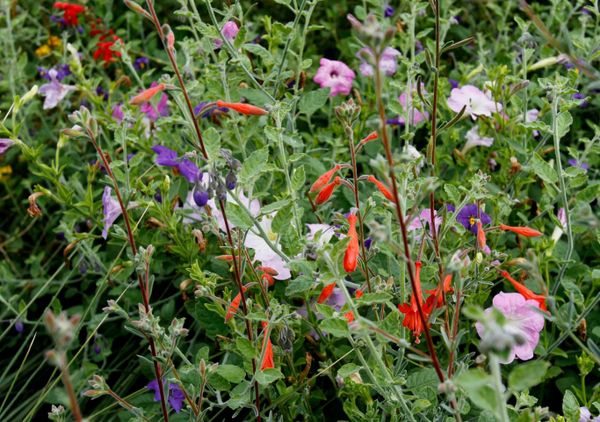
A colorful assortment of drought-resistant plants, which flower in the summer and fall in Kate Frey’s garden.
Garden is planted densely …
Throughout the garden, clusters of plants in vibrant full bloom lean into each other in seemingly haphazard array. “I plant densely to provide as much foraging as possible in an allotted space,” she says.
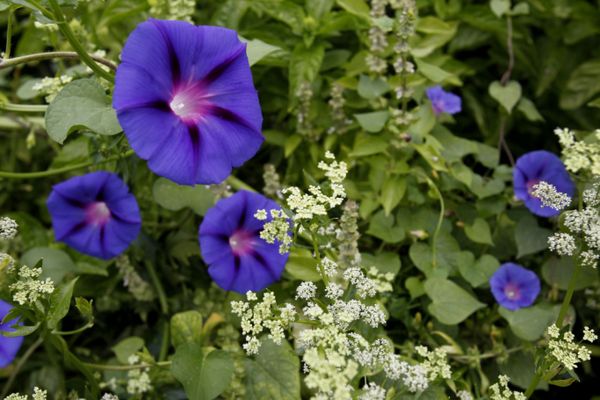
Morning glories, basil and flowering celery make for a lovely contrast in the garden of landscape designer Kate Frey.
But some spaces intentionally left bare …
At the same time, some spaces, usually a small area under consideration for renovation, are intentionally left bare. “There are some 4,000 species of native bees in North America,” Frey explains, “making them among the most important of pollinators. Seventy percent are ground nesting. Needed is a sunny, well-drained, non-mulched, bare spot where they can burrow in.”

A female Anthophora curta Provancher bee, one of 1,600 wild species native to California.
The entire garden is drip irrigated. Seven battery timers ensure that water is delivered according to plants’ specific needs. At any given time, California native plants, efficiently drought resistant, account for at least 50 percent of everything planted. To aid moisture holding, at planting time compost is incorporated into the hole and tucked in around the plant on the surface.
Vegetables are an important garden component …
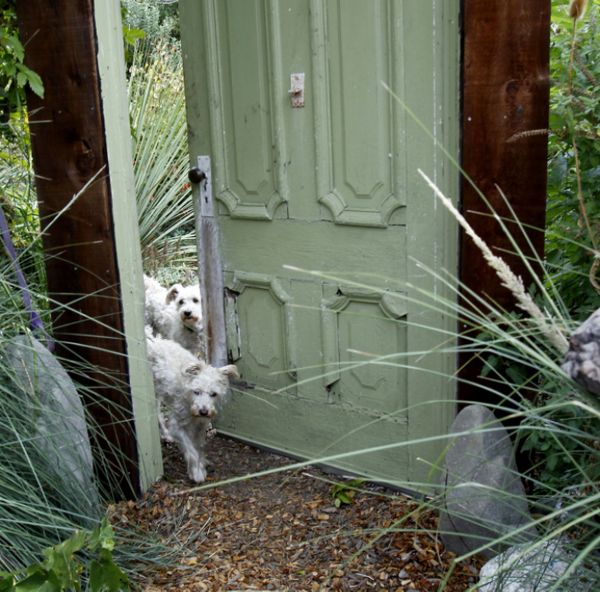
Family dogs walk through a Victorian-era door, one of Ben Frey’s recycled finds, that opens into the vegetable garden.
A Victorian-era door, one of Ben’s recycled finds, opens into the vegetable garden. A flock of chickens, no two alike, scratch about in an adjacent fenced yard. “We let them out an hour or so each day so they might patrol the garden in search of snails and such,” Frey says.
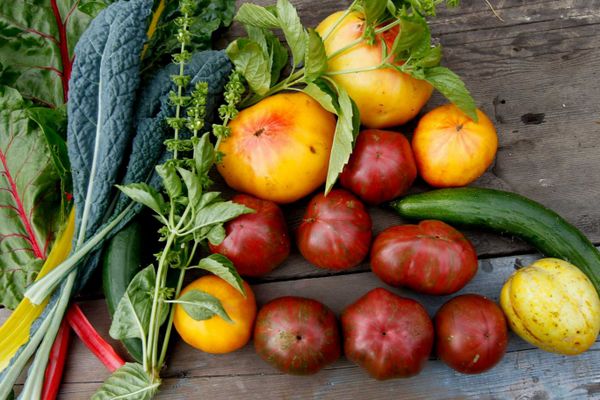
Kate Frey’s garden produces a colorful collection of vegetables.
Recycled-wood creations enhance the garden …
In addition to the vegetable garden door, more of Ben’s artistically rustic, recycled-wood creations enhance the garden — a coop for the chickens; the “hermit’s hut” housing the garden’s tools; a fanciful birdhouse atop a tall pole.
All fits together, a garden designed to delight both wildlife and humans, gold-medal worthy.
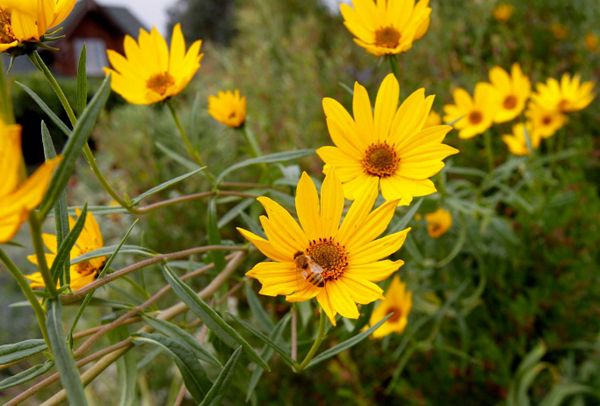
Sunflowers add color and attract plenty of helpful insects and local bees.
